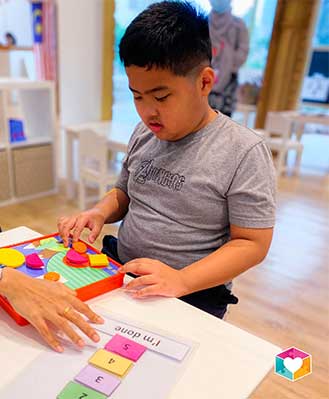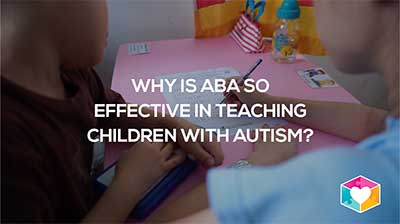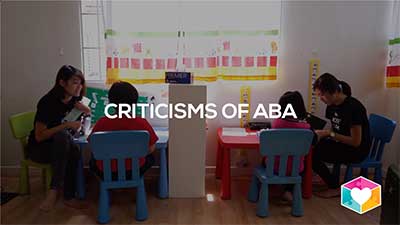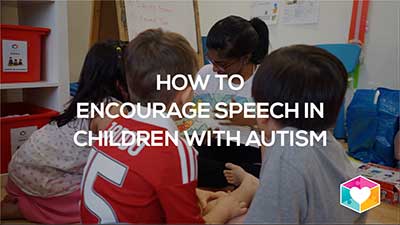0
Cart 0
Type and hit enter


Applied Behavioural Analysis (ABA) is the gold-standard treatment approach for autism spectrum disorder.
ABA is the only research-based treatment for autism with findings that almost 50% of young children who receive good quality intensive ABA are able to catch up to their typical developmental age.
ABA has over 1000 scientific and peer-reviewed journal articles to support the effectiveness of the ABA treatment.
40 states in the USA have state funding or insurance coverage for ABA treatment for children with autism.
ABA is based on principles of operant conditioning. In essence, consequences have an impact on increasing or decreasing one’s behaviour. Complex skills are taught to individuals through the following 3 simple principles:
ABA is essentially a methodology of teaching that can be utilised to teach any skill at any age. In fact most of life has been learned through principles of operant conditioning and ABA. These common sense principles can be applied to individuals of all ages, with and without autism.
As autism is a spectrum disorder, it is critical that each child’s programme is tailored to their needs, age and skill levels.
1 week = 168 hours Free time = 84 hours (minus sleep). Intensive hours of ABA help establish emerging skills and avoid a child staying in their own world.
In the initial stages of treatment, a child with autism requires full focus and attention to maximize their potential.
A child’s brain is still developing in the early years and starting early increases the likelihood of closing the gap.
Complex skills are broken down to smaller components parts to make learning easier, reflecting in a positive learning experience and increased confidence.
ABA uses positive reinforcement to increase positive behaviours and social interaction, and decrease inappropriate behaviours. No adverse teaching is tolerated.
It is essential that a child with autism receives the best quality treatment and therefore, every level of the EAP team receives ongoing supervision and training.
The EAP programme incorporates all areas of development including Early Learner Skills, Language and Communication, Play and Social Skills, Daily Living Skills, Pre-Academic Skills, and Generalisation.

Amidst increasing alternative convincing treatments readily available and advertised, there is still no ‘magic pill’ for the treatment of autism. However, here are 8 key rationale reasons for why ABA remains the most effective treatment for autism to date.

You’ve heard about ABA in our previous videos. Here, we discuss the common criticisms of ABA and how we have overcome it. Our intention is to create a better understanding of ABA and its efficacy.

We some tips to encourage speech in children with autism that have proven effective in our experience over our last 10 years.
Over the last 12 years, we have had the priviledge of providing world-class services to over 400 individuals from 30 different countries.
References
Devlin, S., Healy, O., Leader, G. & Hughes, B.M. (2010). Comparison of Behavioral Intervention and Sensory-Integration Therapy in the Treatment of Challenging Behavior. Journal of Autism and Developmental Disorders, 41(10), 1303-1320.
Eikeseth, S., Smith, T., Jahr, E., & Eldevik, S. (2007). Outcome for Children with Autism Who Began Intensive Behavioral Treatment Between Ages 4 and 7. Behavior Modification, 31(3), 264-278.
Eldevik, S., Hastings, R.P., Hughes, J.C., Jahr, E., Eikeseth, S., & Scott, C. (2009). Meta-Analysis of Early Intensive Behavioral Intervention for Children with Autism. Journal of Clinical Child & Adolescent Psychology, 38(3), 439-450.
Howard, J.S., Sparkman, C.R., Cohen, H.G., Green, G., & Stanislaw, H. (2005). A Comparison of Intensive Behavior Analytic and Eclectic Treatments for Young Children with Autism. Research in Developmental Disabilities, 26(4), 359-383.
Lovaas, O.I. (1993). The Development of A Treatment-Research Project for Developmentally Disabled and Autistic Children. Journal of Applied Behavioral Analysis, 26(4), 617-630.
Sallows, G.O. & Graupner, T.D. (2005). Intensive Behavioral Treatment for Children with Autism: Four-Year Outcome and Predictors. American Journal of Mental Retardation, 110(6), 417-438.
Schrek, K.A. & Miller, V.A. (2010). How To Behave Ethically In A World of Fads. Behavioral Interventions, 25(4), 307-324.
Adding {{itemName}} to cart
Added {{itemName}} to cart